Atmospheric Researcher Hurricane Q&A
(Updated August 2021)
Hurricanes are among the worlds’ most devastating natural disasters, affecting millions in coastal areas each year. The 2017 hurricane season saw unforgiving storms in the Atlantic Ocean, battering the Caribbean, United States, and – to a lesser extent – Western Europe for the better part of three months.
Introduction
One of those devastating 2017 storms was Hurricane Harvey. Impacts of Hurricane Harvey:
- First Category 4 hurricane (winds up to 130 MPH) to make landfall in the United States since Hurricane Charley in 2004
- 30,000 water rescues, 68 fatalities reported
- $125 billion in estimated losses
- Rainfall total reached 51.88 inches at Cedar Bayou near Highlands, Texas
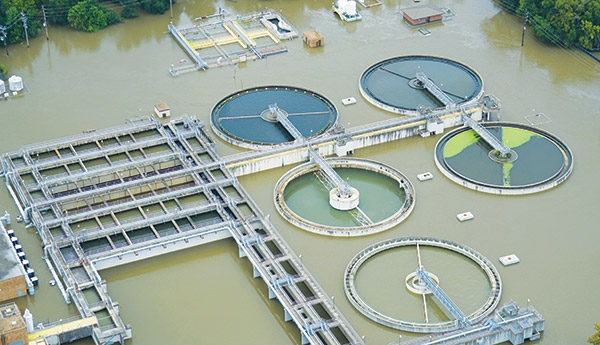
Extensive flooding overwhelmed infrastructure, allowing for the ingress of bacteria and other contaminants.
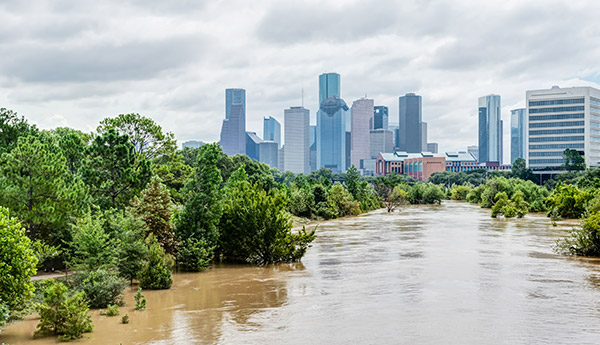
Heavy rain from Harvey contributed to high and fast water on the Bayou River, threatening the greater Houston area.
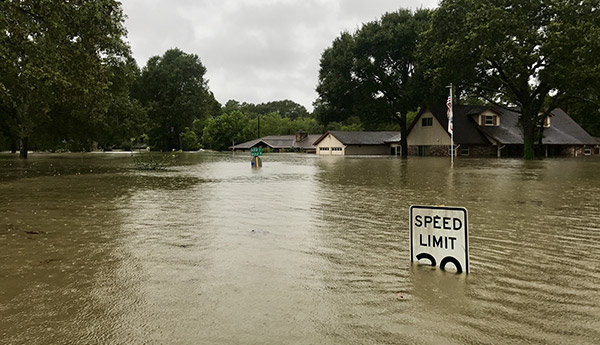
Flooding in Spring, Texas, several miles north of Houston, caused incredible damage in suburban communities.
Eye of the Storm
An Interview with Top Atmospheric Science Researcher, Dr. Phillip Klotzbach
About Phil
Phil Klotzbach is a Research Scientist in the Department of Atmospheric Science at Colorado State University. He received his Ph.D. in Atmospheric Science from CSU in 2007. Klotzbach has been in the Department of Atmospheric Science for the past seventeen years and was a co-author on the Atlantic basin hurricane forecasts with Dr. William Gray through 2005. Since then, Klotzbach has led the development of two-week forecasts issued during the peak months of the hurricane season. He has published over two dozen articles in peer-reviewed journals such as the Journal of Climate and the Journal of Weather and Forecasting.
>> Download full copy of Mission: Water Magazine
Academic & Professional Background
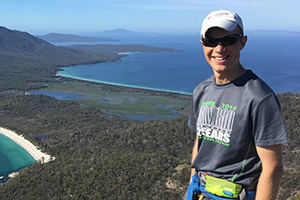 Colorado State University – Ph.D. in Atmospheric Science; M.S. in Atmospheric Science
Colorado State University – Ph.D. in Atmospheric Science; M.S. in Atmospheric Science
Bridgewater State College – B.S. in Geography
- Chair of the World Meteorological Organization’s Seasonal Hurricane Forecasting Panel
- Editorial Board Member for Scientific Reports
- Panelist for National Research Council’s Research Associates Program
Question: What led you to take an interest in atmospheric science?
Phil: I guess you could say I was born with a defective weather gene. I have always been obsessed with the weather since I was a kid. I used to ask my parents to print out flight maps of the U.S. so I could draw weather fronts on them and come up with different weather situations which gave Massachusetts (where I grew up) lots of snow!
And then when I was five years old in 1985, Hurricane Gloria came through. It didn't do a ton of damage, but enough that I became fascinated by hurricanes.
Question:
What type of research are you involved with at Colorado State University?
Phil:
So for the past fifteen years, I've been at CSU doing research in our Atmospheric Science department. At Colorado State we’re well known for our seasonal hurricane predictions. We attempt to predict how active each hurricane season will be before it ramps up. This research was founded by my predecessor who passed away a couple of years ago, Dr. Bill Gray. I’m continuing his research on seasonal forecasting, while also focusing my efforts on tropical cyclones and climate change.
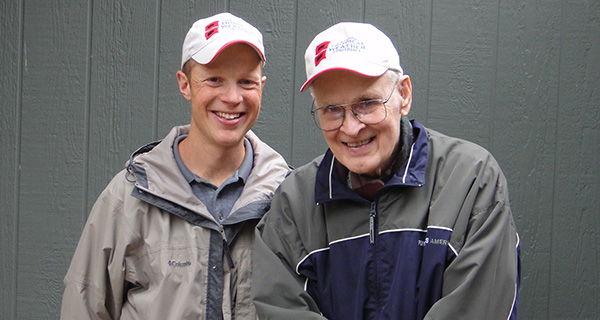
Dr. Phil Klotzbach (left) and hi mentor Dr. Bill Gray (right).
Question: You mentioned Colorado State University focuses heavily on seasonal hurricane forecasting. Can you describe what that is and what goes along with that research?
Phil: It's always been asked "Why are you studying hurricanes in Colorado? …You're not really near any oceans." And my predecessor, Dr. Gray, used to always say, "It's because the storm surge can't get you at 5,000 feet."
But anyways - what we try to do with seasonal hurricane forecasting is to predict how active a season is likely to be. Now, we couldn’t say on August 26th that Hurricane Harvey was going to hit Texas or something that specific, however what we can forecast with some degree of skill is that ‘the season looks more active than normal’, ‘near normal’ or ‘less active than normal.’ And that's because there tends to be certain sets of conditions that reappear in the atmosphere and in the ocean prior to active seasons.
With that said, it only takes that one storm to make it a very active season for a region. Case in point is 1992, where the Atlantic had only one major hurricane that year…It just happened to be Andrew, which was a Category 5 hurricane that devastated South Florida.
Question: To clarify – do you forecast both the number and intensity of hurricanes in a given year
Phil: We predict the number of tropical storms and hurricanes each year, and also the number of major hurricanes, ranked Category 3 and higher. Those are storms with winds of 111 miles per hour or greater.
Question: What kinds of data go into your predictive models and how do you gather that information?
Phil: The modeling has changed over time. Dr. Gray started this research in the early 1980s. In the beginning, he literally called people to pull individual weather station data; barometric pressure from stations in the Caribbean and water temperature measurements from individual buoys. Whereas today, there are globally gridded data available from satellites, data buoys, and ships that are much easier to attain.
I use data sets produced by NOAA, NASA, and groups out of the UK which is available in virtually real-time. There is so much more data available now than there was 30 or 40 years ago.
We have it easy today!
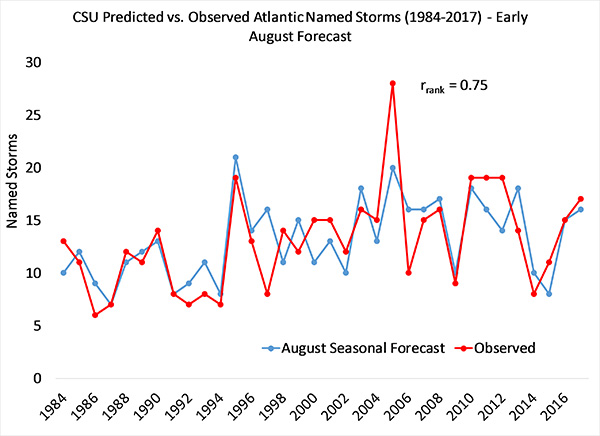
An example of the predictive modeling prepared by Dr. Klotzbach and his team.
Question: Once you’ve built your models and given predictions for an upcoming hurricane season, where does that information go, and how is it used in the U.S. and by others around the world?
Phil: When we put out the seasonal forecasts, I post it on our website and advertise it on social media. We also send out a press release through CSU that goes to various news outlets.
In terms of how people use [the forecasts], we always frame them as an informational tool. People are curious. There's always inherent curiosity amongst the general public about everything. It's the same reason people want to know, who's going to win the presidential election or the Super Bowl.
However, we've documented real-time forecast skill in over 35 years - which is a lot more than can be said for pre-season picks of who is going to win the Super Bowl!
In terms of disaster preparedness, I always stress that people need to plan for every hurricane season the same way regardless of our forecast, because it only takes one hurricane to turn a community upside down. Even in a year like 2017 – which was obviously a very active season with significant impact on the Houston metro area, South Florida and the Caribbean – there were other parts of the U.S. that had no impacts from hurricanes whatsoever.
Outside of our primary users, there is some interest in the insurance industry as well for seasonal forecasts. But it's mostly just for interest's sake. There's not much you can do from a pricing perspective with insurance, because those rates are set months and months before a hurricane could even form.
Question: Is the team at Colorado State University the only group to create hurricane forecasts each year?
Phil: While CSU was the first group to do the seasonal forecast, now there are a wide variety of groups that do seasonal predictions. A colleague of mine from Barcelona and I developed a website to host all publicly available seasonal forecasts. You can check it out at www.bsc.es/seasonalhurricanepredictions. We're up to about 20 universities, government agencies, as well as private sector weather forecasting companies submitting to it.
So, it's a crowded field these days; there are a lot of groups doing seasonal forecasts. But, our group at CSU was the first one to start and we've been doing it convincingly for going on 35 years.
Question: You mentioned some of the more extreme storms from 2017, Harvey and Irma. Could you summarize why the past hurricane season was so intense?
Phil: In the U.S., we actually had a pretty good streak of luck going. In 2004 and 2005, there were two horrible hurricane seasons. These were very active, very devastating, and most notable of all those hurricanes was Hurricane Katrina. The death toll was well over 1,000 people in Louisiana from the levee failures.
But then the U.S. went eleven years without a major hurricane hitting its coasts. Again – a major hurricane is defined as a storm with winds of 111 miles per hour or greater; that's Category 3 or higher on the Saffir-Simpson wind scale.
There were certainly some devastating storms like Sandy and Ike, but nothing strong enough to be a major hurricane. Then in 2017, Harvey and Irma hit the continental U.S., and Maria struck Puerto Rico and Dominica.
I believe for Dominica, the economic impact was approximately 2.5 times its annual gross domestic product, which is absolutely mind blowing. Considering the U.S.’ gross domestic product is something, like $19 trillion. To think about it proportionately… a storm doing $45 trillion in damage is just something you can't even fathom. But that's what happened in a country like Dominica.
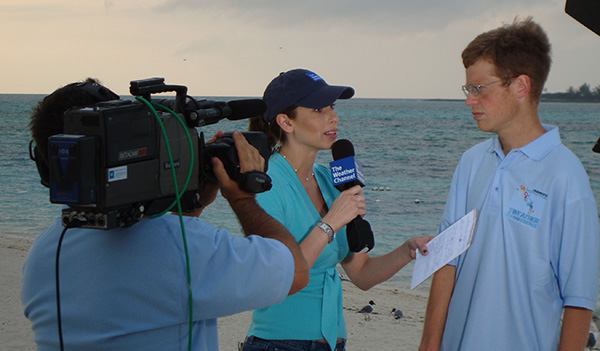
Dr. Klotzbach is a regular expert contributor to weather and news reports, such as The Weather Channel, focusing on the hurricane season.
With Harvey, came a lot of wind damage near where the storm hit in central Texas...Port Aransas and Rockport. But in terms of financial damage, that would have been fairly small given the small population in that general area. But the storm then stalled and drifted very, very slowly east and dropped enormous amounts of rain. We’re talking 40, 50, 60 inches in a couple of places, which is just mind blowing amounts of rain.
The resulting flooding caused immense economic damage in the ballpark of $100 billion, maybe even more. The [National] Hurricane Center released their Harvey Report, and it really is an excellent read. I’d encourage anyone interested to check out www.nhc.noaa.gov to get a copy. There are a lot of good figures in the report demonstrating the footprint of the rainfall from Harvey. It is so much more than what we have seen from some of the nasty hurricanes in Texas’ history.
…And then hot on its heels, we had Hurricane Irma, which was a buzzsaw. It was incredibly powerful; the strongest hurricane in terms of winds in the Atlantic (outside of the Gulf of Mexico and Western Caribbean) on record. Irma had up to 185 mile an hour winds.
What was so interesting in the 2017 season was the intensity of the hurricanes. Typically, the strongest hurricanes are in the western Caribbean or in the Gulf of Mexico where the waters are warmer. But this year, we saw hurricanes like Irma reaching their peak intensity further east in the eastern Caribbean. Consequently, it pummeled several smaller islands; islands like Barbuda, and some of the British Virgin Islands. The Florida Keys were devastated, but the mainland was spared the worst of the storm.
Between the Keys and just before it struck the mainland, Irma was hit by a lot of dry air and some pretty strong upper-level winds. It really disrupted the circulation of the storm, such the back half of the storm weakened. On TV, you could see footage of the water being blown out of the bays; places like Tampa. But then, after the hurricane passed – when you’d normally expect significant storm surge given Irma's track – the winds weren't as strong as was originally predicted. So while we saw some storm surge, we avoided inundations in places like Naples and Fort Myers.
Some of the models were forecasting six, eight, ten feet of water in downtown Fort Myers, which would have been a horrific scene. Even up in Tampa Bay, there was potential for some nasty surge there. Fortunately, with Irma, the mainland of Florida dodged a bullet.
Question: And of course we also felt the impacts of Maria. What are the drivers of such extreme storms and of these extreme hurricane seasons?
Phil: There is a recipe for a perfect storm or perfect season. You need to have a few fundamental factors in play. These were actually first laid out in a 1968 paper written by my predecessor, Dr. Gray. You need warm waters, because hurricanes are basically a heat engine, they live off of warm ocean water. So, if the waters are cool, or the hurricane goes over land, it weakens rather quickly. Typically, a hurricane needs waters of about 80 oF (26.7 oC) to form, and basically, the warmer the waters, the more fuel there is for the storm.
So, this past year, the waters were running about one to two degrees Fahrenheit warmer than normal, which certainly may not sound like a lot. If water is 84 or 86 degrees [Fahrenheit] and you jumped in, you probably wouldn’t even feel the difference. However, when it comes to a hurricane, it does provide a lot more fuel for the storm.
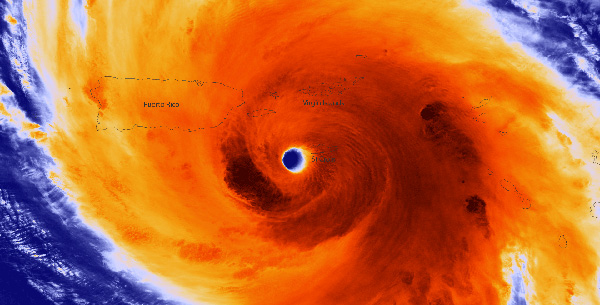
In this colorized infrared image, taken on September 20th, 2017 at 6:15 UTC, the well-defined eye of Hurricane Maria can be seen as it skirts the island of St. Croix. (Image Credit: NOAA/NASA Suomi NPP satellite)
Now, you can have really hot water and still have a quiet hurricane season. You also need upper-level winds to be fairly weak near the storm. Strong upper-level westerly winds tend to tear apart hurricanes as they're trying to develop. Coupled with low-level trade winds that blow out of the east, it's called vertical wind shear. So if you have a very strong change in wind direction high up in the storm, it tears apart the hurricane. When [the National Hurricane Center] talks about individual storms, they always reference vertical wind shear because it's such a critical factor.
You also need lots of moisture in the atmosphere. Dry conditions squelch the development of the thunderstorms, which are the building blocks of a hurricane. And, even with all of these conditions met perfectly, there still must be a disturbance.
There are about 60 to 70 deep thunderstorm complexes, known as easterly waves, that move off of West Africa every year. And basically, when those disturbances move into an environment that's conducive, then they can intensify. Storms like Irma, Maria, and Harvey all form from these waves moving off of Africa. And so, in a year when conditions are conducive, you can see, say, six, eight, even ten of those thunderstorms become hurricanes. Whereas in other years, you may only get one or two of those waves becoming hurricanes in the Atlantic.
There's approximately the same number of complexes moving off Africa every year. The water temperature, wind, and moisture levels in the Atlantic determine whether you have an active season or not.
>> Download full copy of Mission: Water Magazine
So, in the case of 2017, it was a perfect storm. You had very warm waters. If you look in the tropical Atlantic, it was the third warmest on record. Then we had low levels of that vertical wind shear, so the winds were fairly weak. There was also a lot of moisture at mid-levels in the atmosphere.
We had the perfect recipe for an active season. And, if you look back at active seasons in the past like 2004 or 2005, in general, the large scale conditions were fairly similar.
Question: Assuming ocean temperatures rise slightly with global climate change, how would hurricanes be impacted?
Phil: When it comes to hurricanes, the general public generally looks at the damage. Storms are likely going to be more damaging in the future for several reasons. The first has nothing to do with climate change, and that's just the increasing number of people and property in harm's way. More and more people are living along the coastline, bringing along more and more belongings. With these trends you’d expect to see more damage in future hurricanes, even if the storms didn't change at all, purely from the increase in population and wealth along the coast.
Then you also have sea level rise. To the general public, a few inches doesn't sound like a whole heck of a lot…And depending on where they are along the coastline, it may not be. But in other at-risk areas, if there is a rise of six inches or a foot that can dramatically expand how far the storm surge reaches inland. In certain areas, the coastline slopes up really, really gradually, so we’ll see further inundation than we used to.
In the case of a storm like Harvey, with climate change creating a warmer atmosphere and warmer ocean, you do expect to see more rain. It's difficult to quantify exact levels, but some papers propose the rainfall totals were 10% higher with Harvey due to climate change. With that said, whether the region got 50 inches or 45 inches [of rain], it wouldn't have made a huge difference, but it certainly exacerbated the problem.
It's difficult to quantify exact levels, but some papers propose the rainfall totals were 10-20% higher with Harvey due to climate change."
When it comes to the overall intensity of storms, most of the models predict that we may actually see fewer total hurricanes, but they could potentially be a bit stronger in the future. If you look at the observed data and at hurricane numbers, we don't see much of a trend in the Atlantic or globally, say, over the last 30 years where we have reasonably good data. But there is some question as to maybe whether the strongest storms are getting a little bit stronger.
But to me, my bigger concern is...even if storms don't change in intensity, we're going to see more damage from the increasing number of people in harm's way, from sea level rise, as well as increased rainfall.
Learn more about Dr. Klotzbach’s research.

Additional Blog Posts of Interest
Voice of Water | Q&A with Philippe Cousteau
Plastic Debris Wreaks Havoc in the Pacific Ocean
Iceland Stream Warming Study Provides a Preview of Climate Change
Life After Deepwater Horizon | Remediation Efforts on the Gulf of Mexico